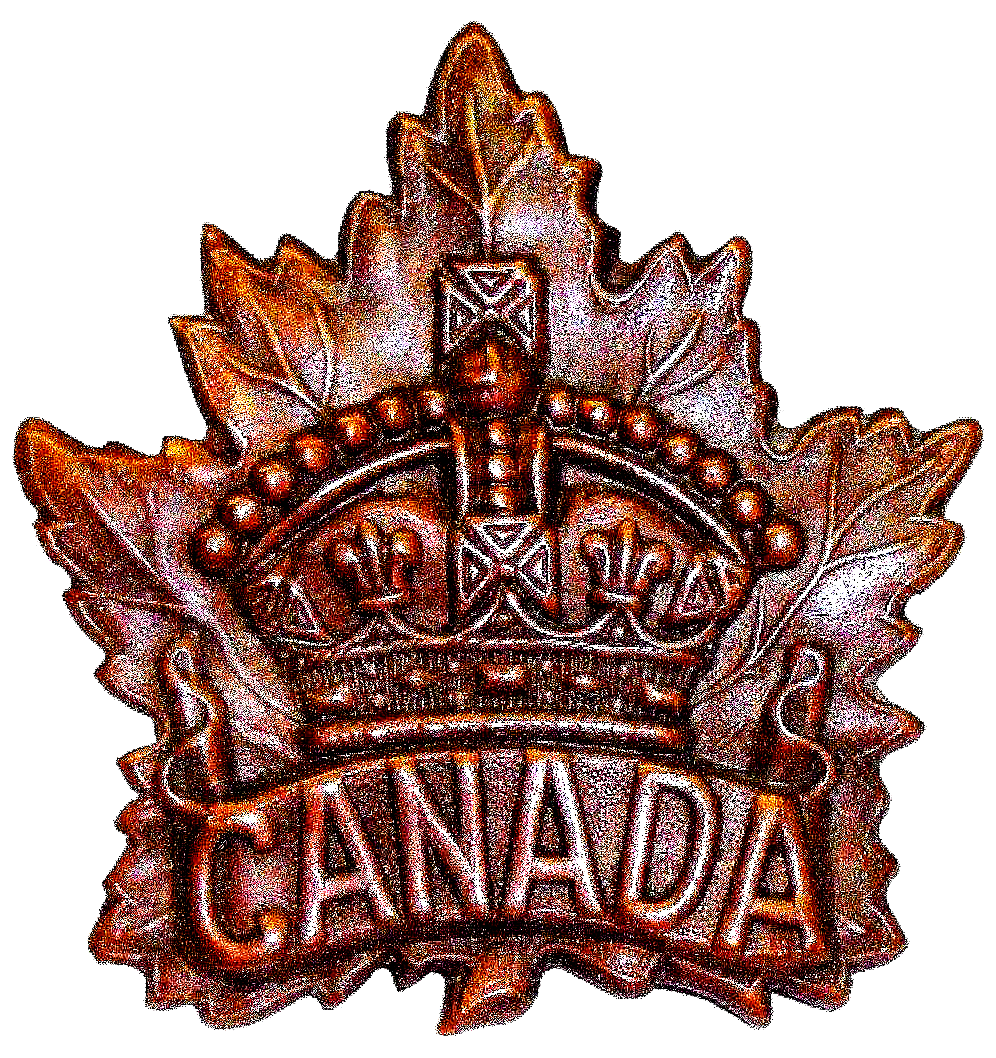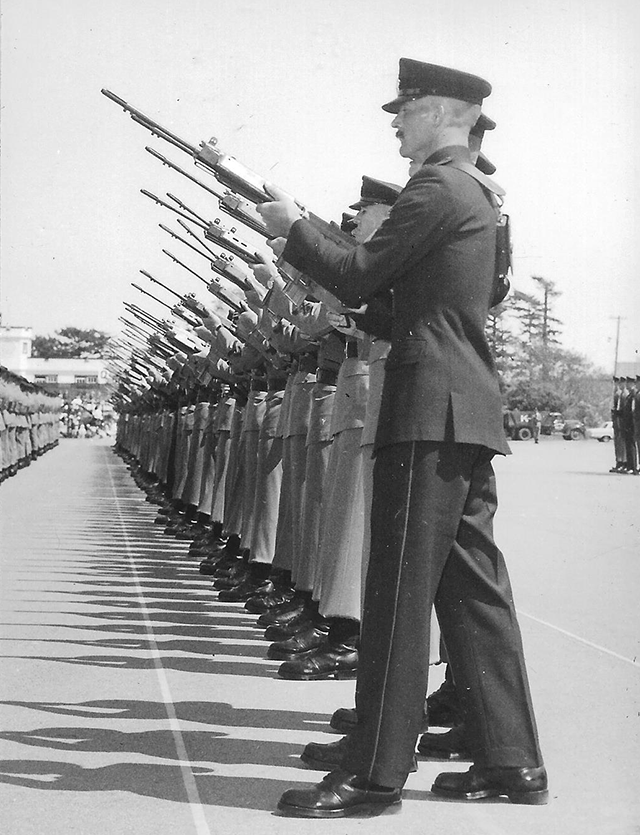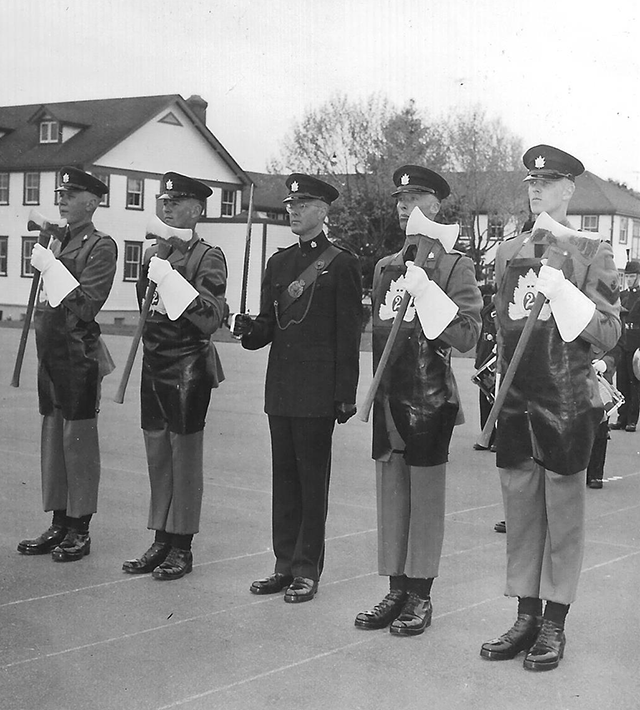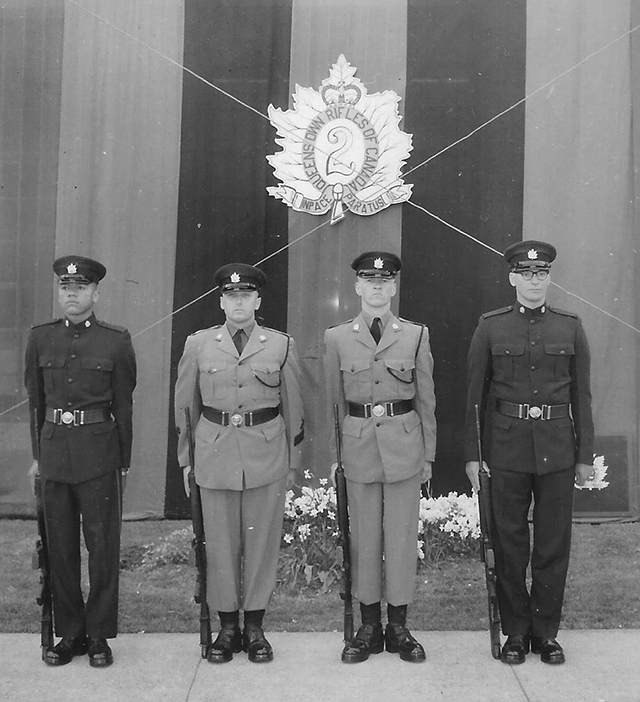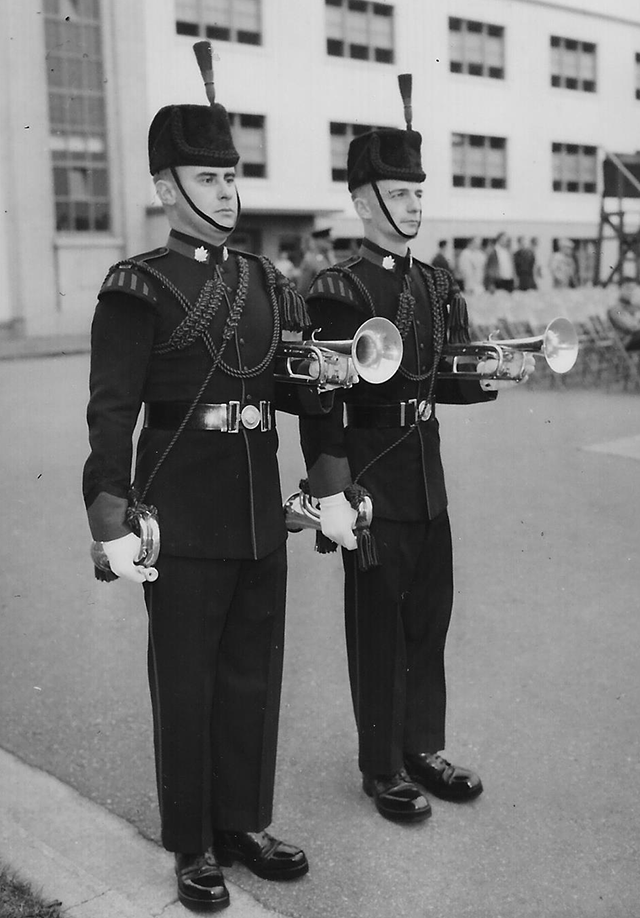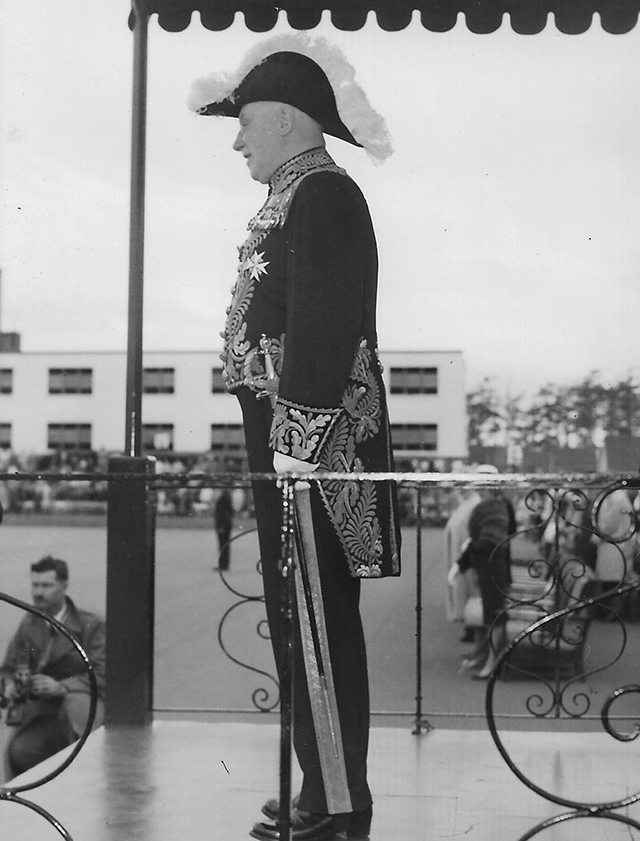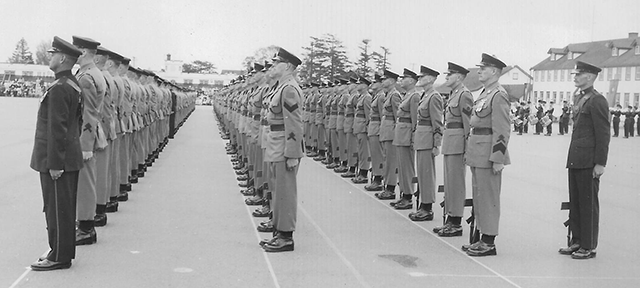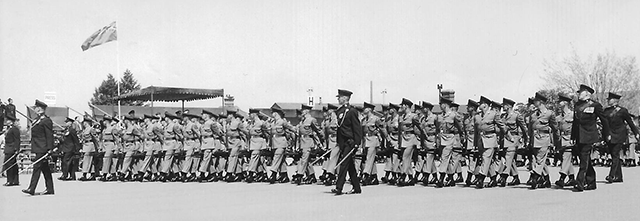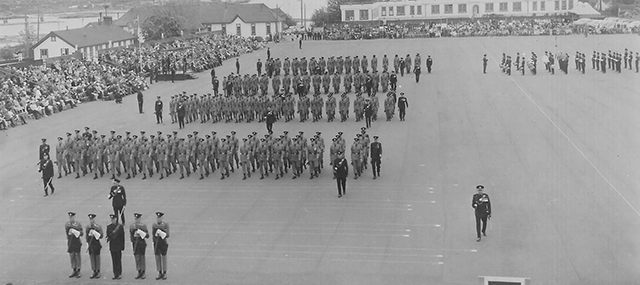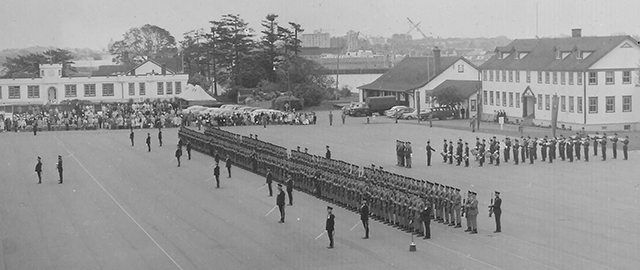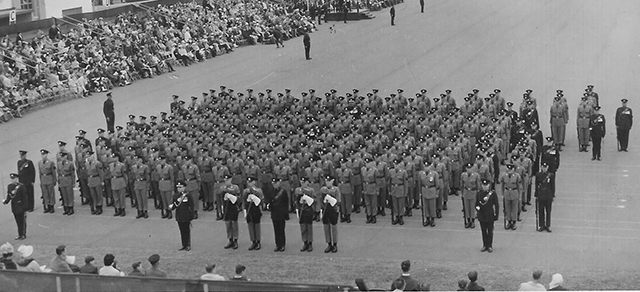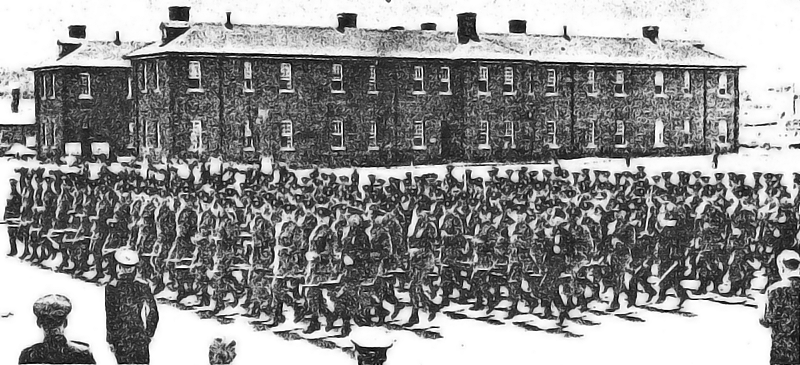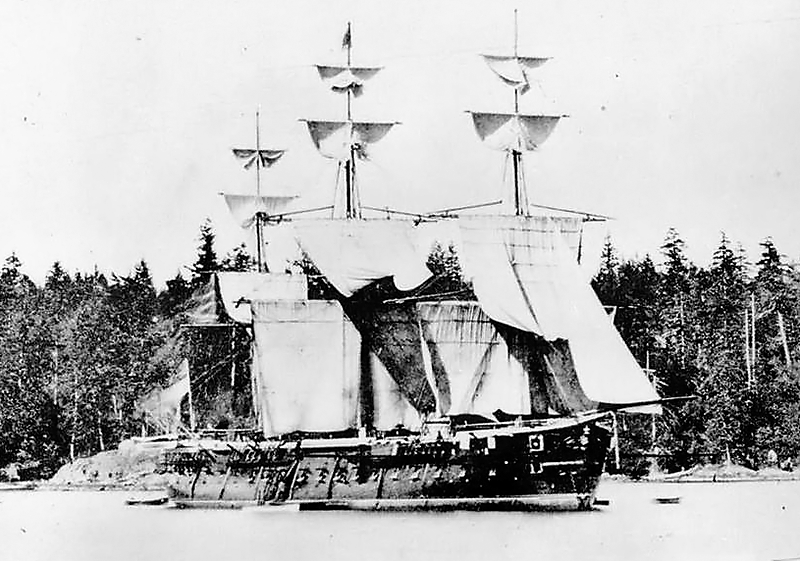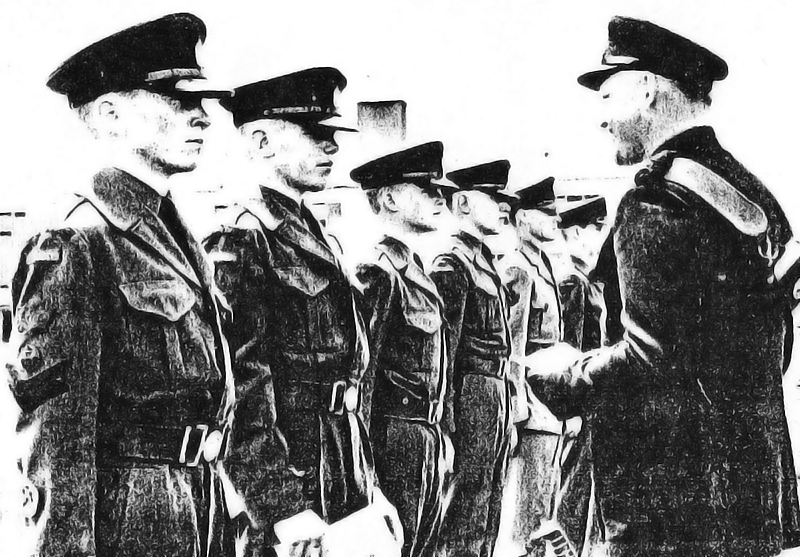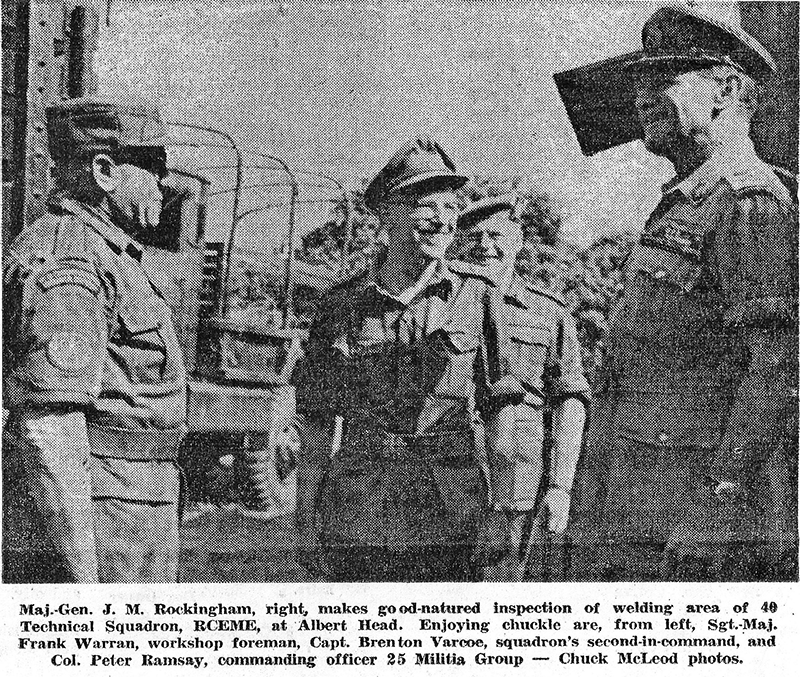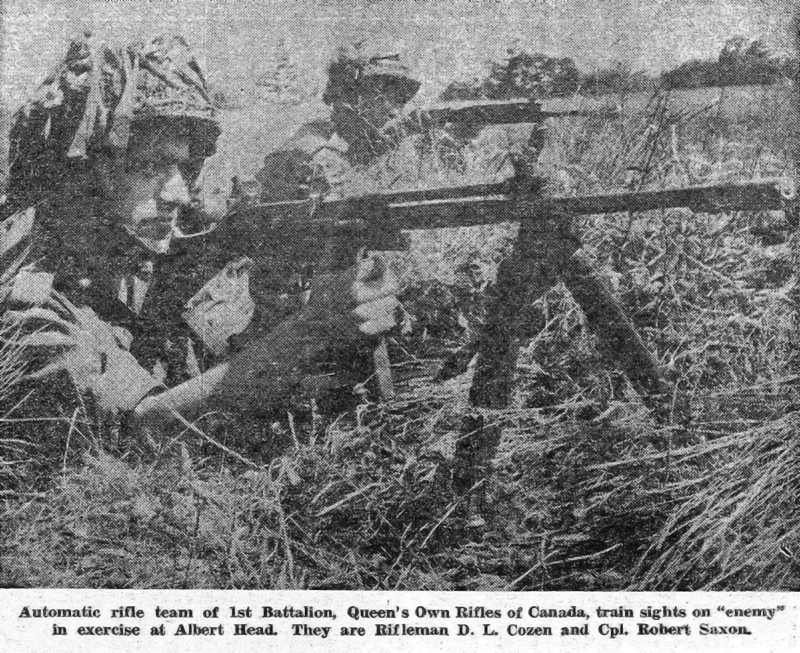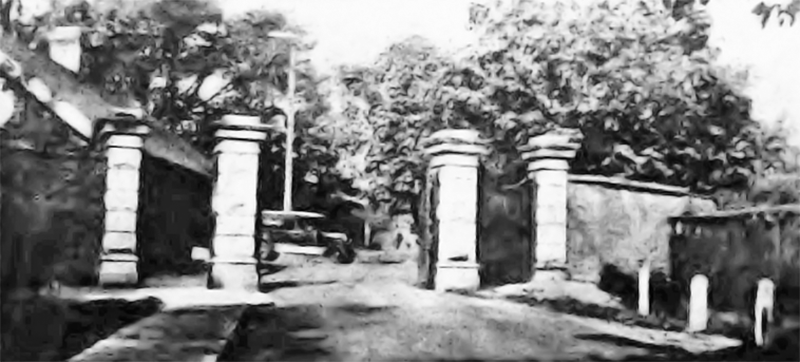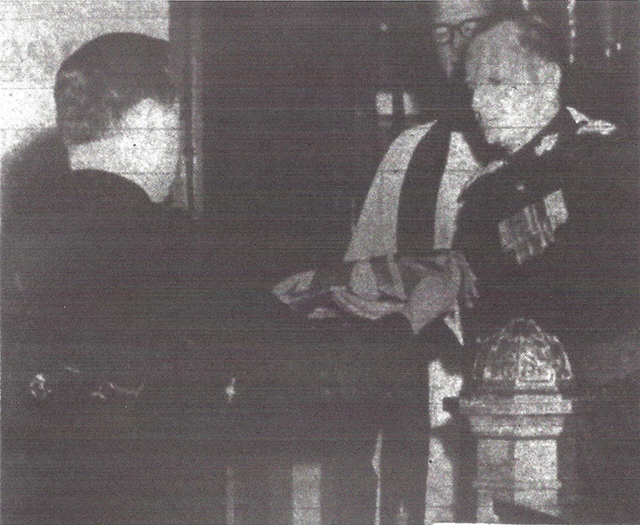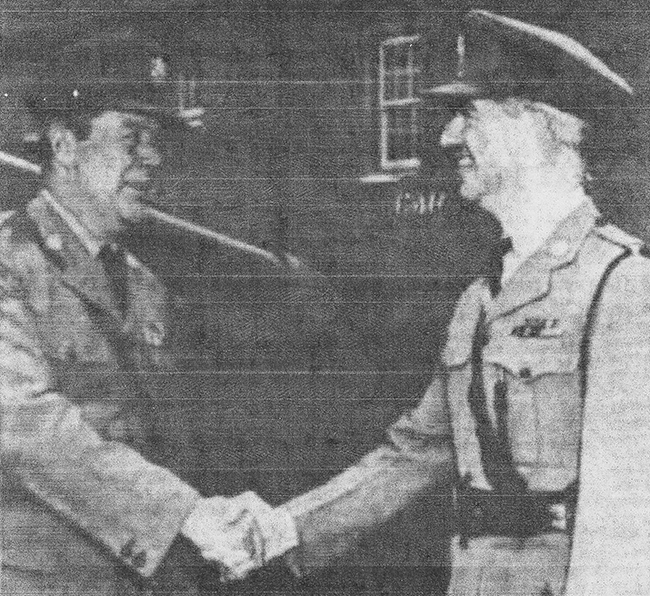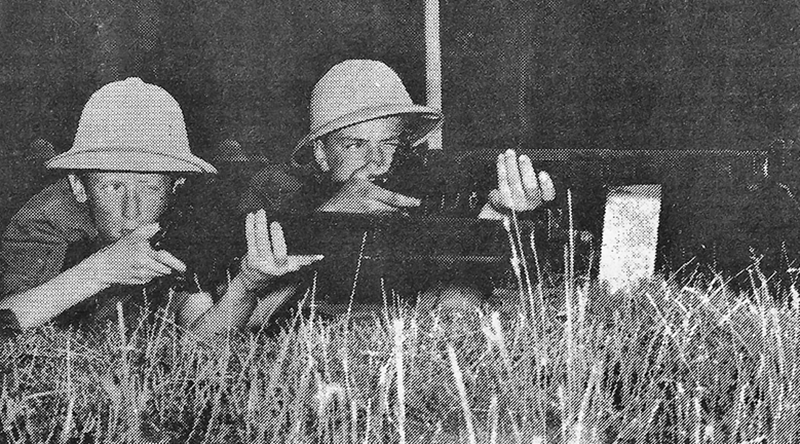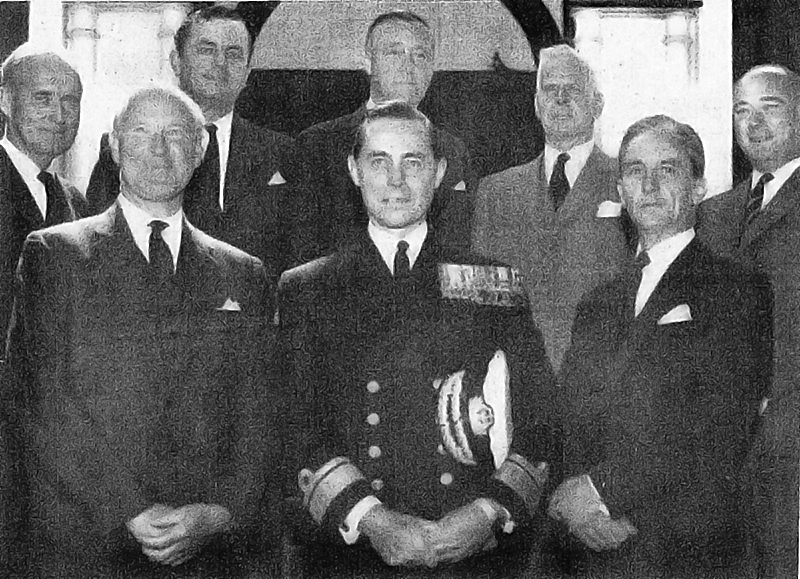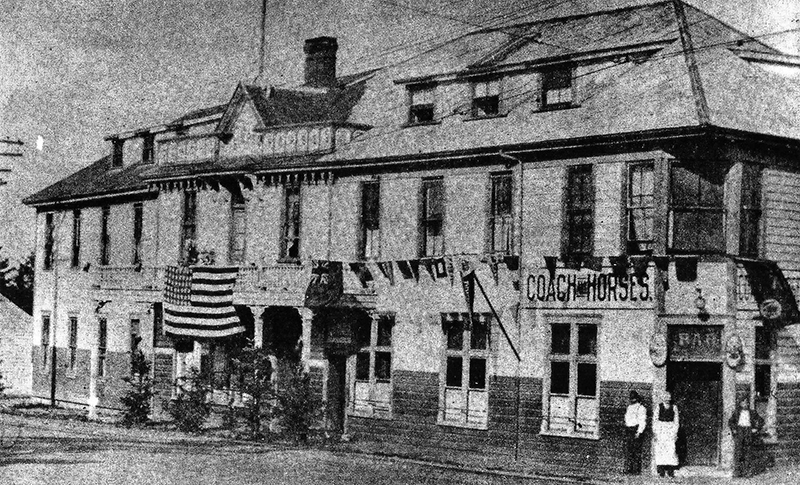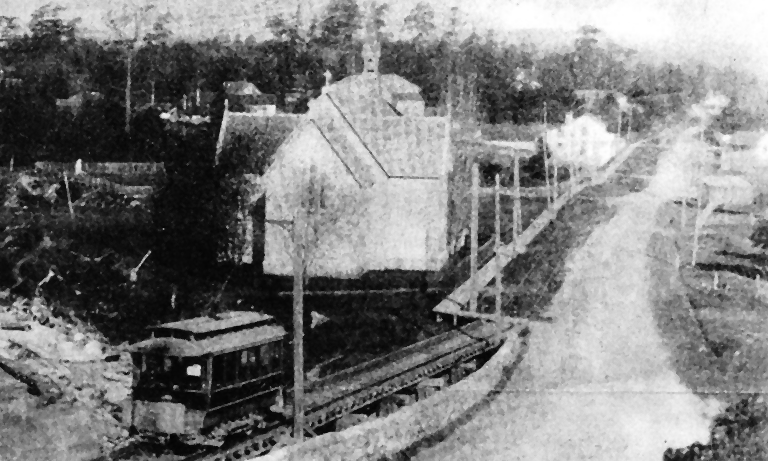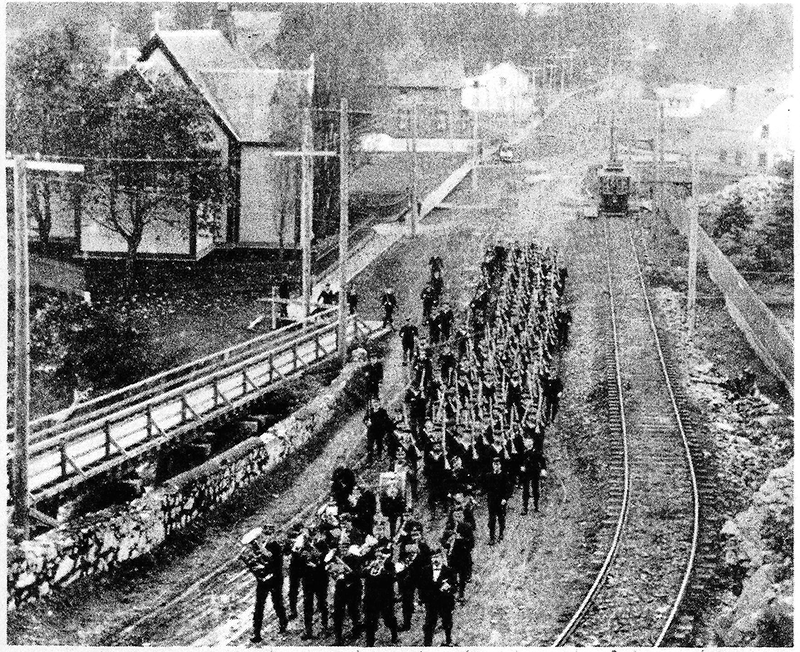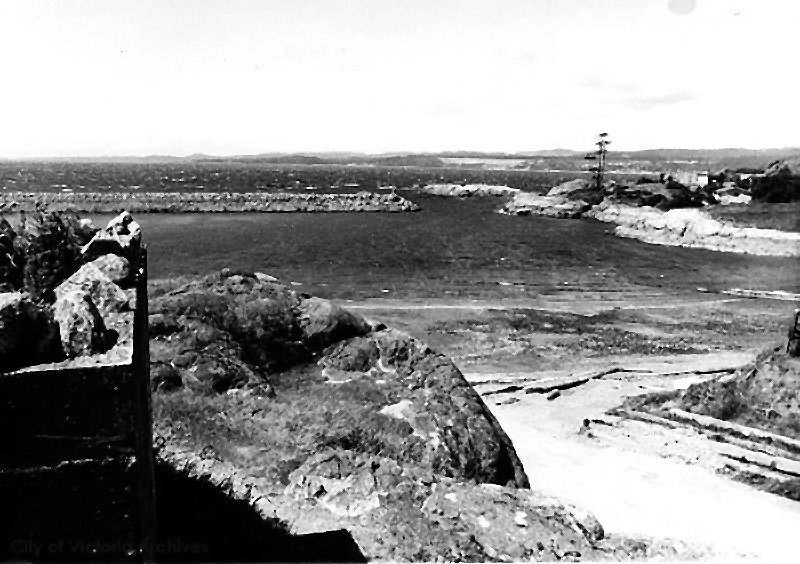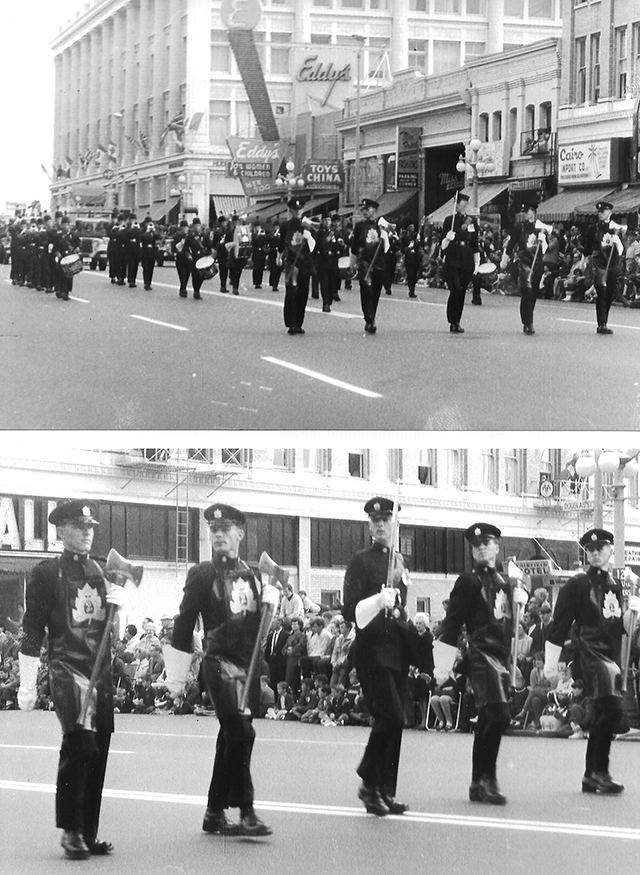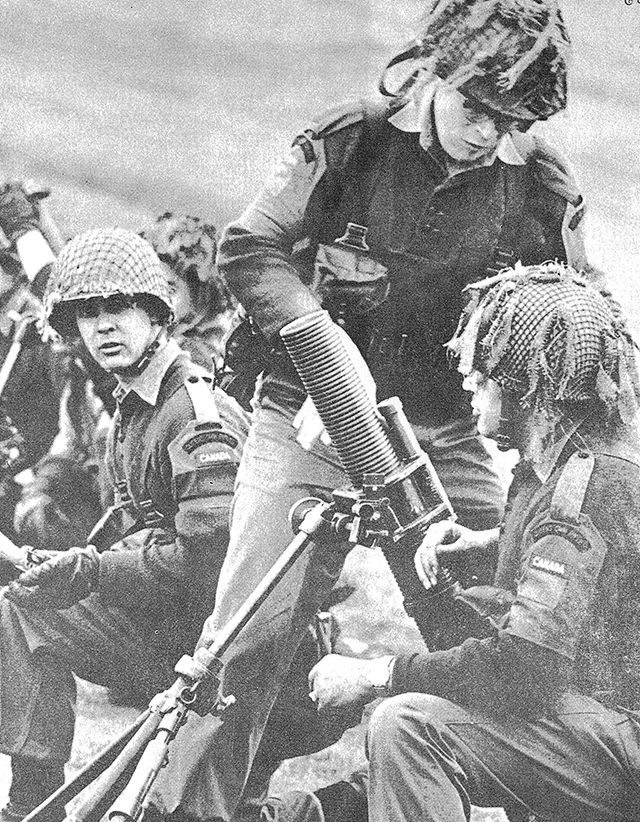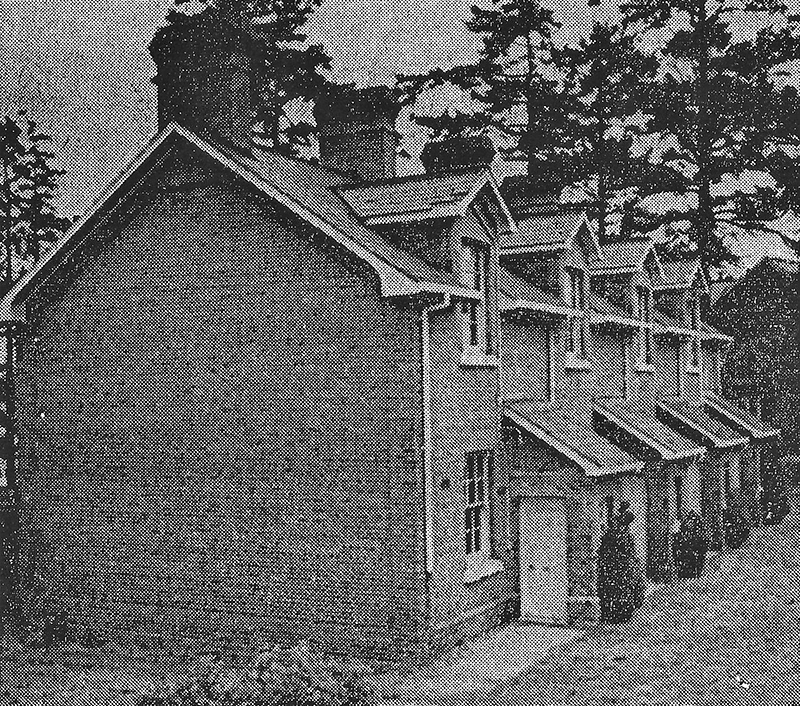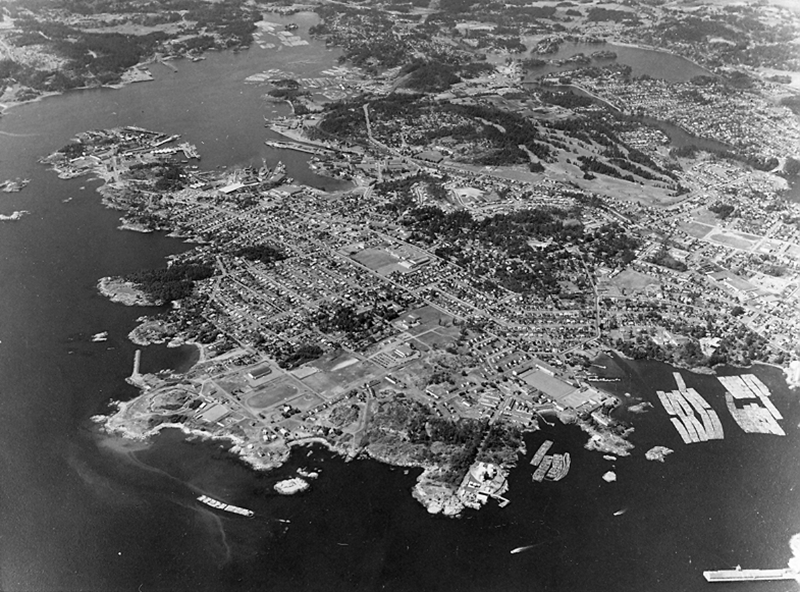 |
 OPCMHVisitor No.: |
HISTORY OF WORK POINT BARRACKSby Jack BatesPART 8 — 1964 to 19701964Enter the 1st Battalion Queen’s Own Rifles of Canada to Work Point Barracks. Of the vast amount of Canadian military history in Esquimalt, the six years the Queen’s Own Rifles spent here played a large part. Many thanks to M Gen (Rtd) Herb Pitts for his contribution to this history. The Powder Horn 1ST BATTALION RETURNS HOME At the time of writing, the 1st Battalion is busily involved with the countless problems which arise from moving over 1500 persons from one continent to another. For almost all of them, it has been three years of duty in Germany with Canada’s NATO contribution – 4 Canadian Infantry Brigade Group. By Christmas 1963, the Battalion will be settled in its new home at Work Point Barracks, Victoria, having been replaced in Fort MacLeod by the 1st Battalion Princess Patricia’s Canadian Light Infantry. In the field, the battalion is noted for its surprising marching ability and highly effective tactics. The Riflemen earned high praise from the German troops against whom they were pitted in the two autumn exercises. The Battalion will be returning to Canada with many pleasant memories and a number of permanent reminders of their stay here. Seventy nine men are returning with German brides, and Rifle families have added an additional 225 children to the dependents list under the heading “born in Germany.” NO. 2483 ESQUIMALT (QOR OF C) CADET CORPS By Lt WD McKay No. 2483 Esquimalt Cadet Corps is a corps new to the Queen’s Own Rifles affiliation. The corps was originally formed in September 1953 as the No. 2483 Royal Canadian Army Cadet Corps. Since that time, it has been variously designated and re-designated as: No. 2483 Independent Order of Forrester’s Cadet Corps – 8 Dec. ’53. No. 2483 The 5th West Coast RCA Cadet Corps – 1 Sept. ’55. No. 2483 The Esquimalt (PPCLI) Cadet Corps – 1 Aug. ’58. Although the affiliation with The Queen’s Own Rifles of Canada dates from the 8th of November 1963, the affiliation in fact began on the 20th of December with an inspection of the corps by Major KN Weber, DSO, CD, Second in Command of the First Battalion. Since that time the battalion has supplied instructors, transport, equipment and facilities for training. In the previous months the corps experienced difficulty in carrying out its training programme. Many courses were impossible because of the lack of training space and poor weather. The drill hall on Macaulay street, which houses the 1st Battalion transport section, was for many months filled with baggage going to and from Germany. As well, the extra work accompanying rotation left the corps without regular assistance of any kind. However, the corps is now speedily gaining ground, particularly in drill. The NCO’s of the 1st Battalion, on a voluntary basis, have been training the cadets in “Rifles” drill, and results have demonstrated the excellent job done on short notice. Although much yet has to be learned in matters of drill, both the NCO’s and cadets are confident that the annual inspection and parade scheduled for the 31st of May will be a good one. Of assistance in achieving a high standard of drill will be a drill course of four days duration during the school Easter holidays. In May also, the corps confidently hopes to compete in a Tri Service cadet drill competition held annually in Duncan, B.C. M Gen Herb Pitts “Introduction to the City of Victoria took the form of participation in the Victoria Day parade and the firing of a Feu de Joie at the barracks. 3000 persons attended the ceremony. In March, assistance was given to Port Alberni to deal with the aftermath of the Tsunami.” The Leader ON THE DOUBLE About 7,000 Victorians were thrilled by the First Battalion Queen’s Own Rifles “Feu de Joie” Friday and Saturday on the double-time march down the parade square intrigued most in the ceremony. Precision at such a speed was quite a sight to behold. The Battalion Bugle Band, officers and men certainly showed they are a well-drilled unit of Canada’s armed forces.
THE LEADER ON THE DOUBLE About 7,000 Victorians were thrilled by the First Battalion Queen’s Own Rifles “Feu de Joie” Friday and Saturday but the double-time march down the parade square intrigued most in the ceremony. Precision of such a speed was a sight to behold. The Battalion Bugle Band, officers and men certainly showed they are a well-drilled unit of Canada’s armed forces.
Daily Colonist INSPECTION TODAY FOR CADETS Annual inspection of the 2483 Esquimalt Queen’s Own Rifles of Canada cadet corps will take place at Work Point Barracks parade square, at 2 p.m. today. Lt. Col. H.C.F. Elliot, commanding officer of the 1st Battalion Queen’s Own Rifles will make the inspection. The cadets will hold a drill and band display, map reading, signals, first aid and national survival demonstrations. The public is invited and there will be refreshments afterwards in the men’s dining room. COLONIST “THE FENIANS!” WAS THE CRY FLAMES ERUPTED IN VICTORIA Vancouver Island was in a state of emergency 96 years ago. While members of the Volunteer Rifle Corps and special constables patrolled Victoria streets, British men-o’-war stood at the alert in Esquimalt Harbor and cruised Juan de Fuca Strait. This is the little-known period of Victoria’s exciting history when it was feared the city was to be the invasion target of the outlawed Irish nationalist society, the Fenian Brotherhood. It had come to the attention of Lieutenant-Governor Frederick Seymour and Admiral Hastings in February, 1868, that the Fenians, who had already attempted an invasion of Eastern Canada two years earlier, had decided to attack the West Coast. Extensive defence measures were immediately ordered into effect. Civilians were pressed into service, the jails and armories strengthened, and armed guards stationed around the city’s banks. And new breech-loading rifles were issued to the reinforced San Juan Island garrison. Victorians had good cause for concern. Every day the Colonist headlines reported Fenian outrages in England, as the Irish independence movement picked up speed and strove to ignite a full-scale revolt. Bombings, murders, sabotage and raids on arms depots were daily occurrences. The British parliament met in emergency sessions to discuss the deteriorating situation. Suddenly the troubles began to assume horrendous international dimensions. Britain was also deeply concerned with the war in Abyssinia. The U.S. was involved with the impeachment of President Andrew Johnson. Tempers grew short. When Britain demanded that the U.S. help control the Fenians, a “festering sore” (most of the instigators in the United Kingdom were American citizens), Congress replied that it had troubles enough. Not only that, but the U.S. was growing impatient for settlement of the Alabama claims. These were the reparations demanded by the American government for damages caused by English built and English manned Confederate commerce raiders during the Civil War. As these issues grew to a head, the question of war between the two nations was seriously debated by both governments. The armed forces were alerted. The world waited tenuously as a special American delegate hurriedly sailed for talks in London. Although rumors had been sweeping Victoria for days, the Colonist first gave a full account of the suspected attack in an editorial on Feb. 25. “A number of absurd rumors were about yesterday concerning an anticipated Fenian raid, not one of which, we are happy to say, is correct. As we stated yesterday, every precaution has been taken by Admiral Hastings and the police authorities, in the face of which he must be a fool or madman who would attempt an outrage. No doubt is entertained, however, by the authorities that a raid was contemplated by a band of men in California and that an emissary was sent among us to feel the ground. Finding, however, that his coming was heralded and he was being watched, he made himself “scarce,” and has not been seen since the sailing of the Eliza Anderson on Thursday morning last. “This is the whole story. There is not the slightest foundation for the ridiculous rumors in circulation about town, and whatever danger there may have been a week ago, the admirable defensive measures taken have removed beyond the range of possibility the success of a hostile movement. But as in time of peace it is the “correct thing” to prepare for war, too great energy cannot be displayed in adoption of measures calculated to deter lawless characters from even entertaining such an idea as the invasion of Vancouver Island. Other Colonist pages were crowded with reports of further rioting in Britain and of trials for treason of leading Irish freedom-fighters. Mighty HMS Zealous continued gunnery practice in the strait. It was hoped that this display of strength would help discourage the Fenians. Although it had been reported that the Fenian “emissary” had departed from Victoria, authorities believed that he was still present. Admiral Hastings assured the public that “…we do not anticipate in the face of the precautions adopted any serious trouble at present.” But as the threat continued to prey upon the minds of Victorians, the Colonist’s editor attempted to ease their fears with humor, reporting the “Brave Capture of a Fenian.” “A veritable Fenian was captured in the outer harbor yesterday. It is supposed he arrived off Race Rocks during Sunday night, intending to run in under cover of the fog in the morning; but the fortunate appearance of the Zealous in Royal Roads, and the sound of her great guns, apparently confused him, and he attempted toward the American side. His movements were observed, however, by a patrol boat from this city, which had gone out early in the morning in search of just such characters. Chase was given and after a pull of some miles the Fenian was captured after a stout resistance by the brave fellow in the boat and conveyed to town, where he was ascertained to weigh 122 lbs. He was cut up into halibut stakes (sic) and retailed at one bit per pound by his captors.” In Britain the Fenians were looked upon with little amusement, as Earl Mayo, Chief Secretary for Ireland, asked that Parliament suspend the writ of habeas corpus, in effect establishing martial law. He maintained that “although the government has succeeded in suppressing the rebels, still an extension of its powers is necessary to enable it to complete its work.” The bill was passed. Additional troops were rushed to the strife-torn city of Dublin. The Colonist reported that the Fenian organization in the U.S. had been placed on a “war footing,” indicating that an actual invasion of Canada was indeed contemplated. At 4 o’clock on the morning of March 6, the cry “The Fenians!’ swept Victoria. A special constable patrolling Government Street had turned in the alarm that Cleal’s Restaurant was burning. It was Fenian practice to set a fire to create a diversion, then strike the banks. Admiral Hastings, immediately informed, took no chances. As Chief Engineer Kelly and his men of the Tiger Fire Company rushed to the scene, a detachment of 50 Royal marines was hurriedly put ashore from HM gunboat, Forward. Emergency police officers also received the call. While the firemen fought to control the rapidly spreading flames, the marines and constables took up positions around the town’s banks. The inferno, fanned by a harbor breeze, spread to surrounding buildings. A young firefighter named Joseph Davies, while supporting a hose, slipped from the roof of the restaurant and fell into the middle of the flames, but remarkably escaped with only slight cuts and bruises. A few hours later the flame was under control and Chief Kelly inspected the smoldering ruins. His suspicions of arson were confirmed. As this information was rushed to the authorities, the marines and police waited apprehensively. But dawn came without sign of a Fenian attack. As it became apparent that it had been a false alarm, the city breathed a sigh of relief. Subsequent investigation resulted in the arrest and committing for trial of the restaurant’s owner. He had apparently lost the same business under similar circumstances two years before. But the charge was eventually dismissed for lack of evidence. The following day, a “practical joker” wrote to the Colonist warning of a plot to disable the town’s fire engine, cut the alarm ropes, and set fire to the city. Although most recognized it as being from a crank, others, their nerves already strained, grew increasingly apprehensive…As days passed without appearance of the invaders, the Colonist and the British Columbia of New Westminster engaged in a public argument as to which city was the more desirable target! The Colonist editor pointed out that New Westminster was unlikely to be raided as it was a town “whose poverty is so notorious as to hold out every inducement to plunderers to give it a wide berth.” He reminded Victorians that “every precaution has been taken, every assistance rendered by the fleet, and every probable point of attack is at least well-guarded from assault; but it will require the presence of all Her Majesty’s vessels now on this station to lie within easy call of Victoria and Esquimalt for some time to come to overawe any evil-disposer ! persons who may cast longing eyes upon our wealth, and who may hope by a sudden raid to strip the banks of their gold. “New Westminster, as we have already remarked, finds her greatest protection in her poverty. She possess nothing worth stealing, and the general who would attempt to march a force so far into the interior of the colony before he had first secured the point of supply and the “key” to the position (Victoria) lying directly in his path and from which he could be harassed by a “fire in the rear,” would be a greater dolt than the alarmed genius at the Capital who has suggested that the Fenians will quietly gobble up our “worthy Governor” and hold him as a hostage while dictating terms for the “liberation of Ireland.” “The government by remaining at New Westminster is safe—too safe for the interests of this section of the colony. Its duty call is here. An undue concern for its own importance and value (which is not shared by any of its subjects) impels it to remain remote from the only probable scene of action in case of an invasion. At Burrard Inlet, where much valuable mill property is at stake, the presence of a gunboat would, perhaps, be advisable for a short time; but the proposition to send a ship of war to New Westminster, where there is virtually nothing to protect, is so monstrously absurd as to admit of no feeling but one of pity for the imbecility of the writer who has given it utterance.” Newspapers took much freer rein in those days ! It must be remembered that Victoria and New Westminster were vying for the honor of being named capital of the newly-combined colony of British Columbia and Vancouver Island. On March 14, HM gunboat Grappler took up position to guard New Westminster and Burrard Inlet. March ended with Admiral Hastings holding a review of HM forces in Beacon Hill Park and ordering of HMS Forward to conduct firing practice in the strait. During the Days of Crisis - It was a False Alarm
Modelled on the French Revolutionary Jacobins and named after a legendary band of warriors called “Fenians” or “Feinnes,” the Fenian Brotherhood was established in the U. S. in 1858. Its fanatical members swore an oath of “allegiance to the Irish Republic, now virtually established,” and swore to rise in arms when called upon. They also agreed to yield total obedience to their officers. Although Fenian chapters soon existed in almost every country in the world, the party never gained popularity with the Irish majority, the agricultural laborers. But during a brief career the society kept the world’s attention focused on Ireland, as it created one furore after another. With the end of the Civil War, thousands of the Irishmen who had served swelled the ranks, making it a formidable organization. The same year, 1865, the party split over the question of invading Canada. The fanatics demanded that Canada be conquered and “used as a base of operations against Britain.” The official — and logical — view was that such action would do little, if anything, to aid the Irish Revolution. But when Britain quelled the uprising in the Emerald Isle, plans for the invasion of Canada were completed. Canadian grew apprehensive as it was reported that thousands of armed men were beginning to gather along her southeastern border. It was the Fenian design to enter Canada with three forces, one striking at Fort Erie, another attacking Prescott in a salient aimed towards Ottawa, and the third force slashing northward through the Eastern Townships. In March 1865, the Canadian government asked for 10,000 volunteers. Fourteen thousand answered the call. The following month a small band of raiders was discouraged from attacking Campobello Island in Passamaquoddy Bay by U.S. authorities and the presence of British warships in the vicinity. Although no major invasion occurred in 1866, two minor attempts were made. On June 2, “Inspector General” John O’Neill, a cavalry officer in the Civil War, led 800 men across the Niagara River into Canada near Fort Erie and camped at Ridgeway. However, many of his followers soon began to desert him. He was immediately attacked by a slightly larger Canadian force but confusion in the Canadian commands cost them an easy victory. As strong volunteer reinforcements advanced, O’Neill ordered a retreat. A detachment of 80 volunteers delayed his withdrawal at Fort Erie in a gallant but vain attack. The Canadians lost ten men killed and incurred 40 wounded. Fenian casualties were thought to be twice as many. The remnants of the invaders surrendered to the U.S. warship Michigan on June 3. The following day a Fenian army 1,800 strong marched from Vermont into Missisquoi County in the Eastern Townships. Camping at Pigeon Hill, roving bands of drunken raiders plundered the towns of Frelighsburg and St. Armand. However, they retreated into the U.S. a few days later. The next thrust came two years later, when it was feared that Vancouver Island would be the battleground. But the attack never materialized. The strength of the Pacific Squadron of the Royal Navy undoubtedly discouraged any such plans. But Canada was kept in a constant state of tension, although the U.S. and Britain resolved their difficulties and remained at peace. (An International Tribunal settled the Alabama Claims in 1872, awarding the U. S. $15,500,00 in damages). In 1870, O’Neill, now president of the Fenians, again struck the Eastern Townships. But after coming under fire at Eccles Hill on May 25, he withdrew. U.S. authorities, finally tired of the business, arrested him. The following day the last Fenians were routed in a brief skirmish at Huntingdon. In October, 1871, without sanction of the Fenian Brotherhood, O’Neill seized the undefended Hudson’s Bay post Ft. Pembina, about three miles north of the Manitoba-U.S. border. Four hours later U.S. troops intervened, arrested O’Neill and his supporters. This is probably the only occasion in Canadian history when American cavalry arrested anyone on Canada’s soil ! However, the raiders were soon released on a technicality. But the Fenian movement was dying and Canada was never again attacked. Condemned for its clandestine activities by the powerful Irish Catholic Church, with most of its leaders imprisoned, and with the American government finally clamping down on its militant actions, it soon disbanded. Ironically, in the long run the Fenian raids proved beneficial to Canada. Military appropriations were increased and the militia reorganized into an efficient force. And the attacks encouraged the provinces to support the Confederation plan then before the voters, resulting in a unified and strengthened nation. — T. W. Paterson Another great article by T. W. Paterson, see February 16, 1992 for a revised version of this story. Esquimalt Leader QUEEN’S OWN RIFLES WORK POINT. After the recent successful Feu de Joie it was the turn of the junior and part time members of thr Queen’s Own Rifles to display their parade square drill. No. 2483 (The Queen’s Own Rifles of Canada) Cadet Corps held its annual inspection Sunday at Work Point Barracks. Forty cadets paraded before ssembled parents and friends. The cadet corps marched smartly on to the parade square lead by their own 16 piece bugle band and there awaited the arrival of the inspecting officer, Lieut. Col. H.C.F. Elliot CD. Lt. Col. Elliot inspected the corps accompanied by Capt. F.N. Fotheringham and Capt. W.A.B. Gabriel, the corps chief instructor and BC Area Cadet Officer respectively. The award for the “most proficient cadet” in the corps was presented to Cadet Sergeant J.F. Clark. Sergeant Clark, in the past year, has been proficient in such varied corps activities as shooting, sports, first aid, drill and band. Cadet Corporal Phillip Watt was presented with the “most improved cadet” award. This was awarded to Cpl watt because of his keen interest and hard working within the cadet corps despite his being only a 1st year cadet. The Robert Walker trophy, a shooting award, was presented to Cadet WO 2 Brian Watt. WO 2 Watt’s shooting ability has made him eligible to compete in Bisley England this summer. The trophy for athletic ability displayed in the corps, the Brigadier Colquhoun trophy, was won this year by Cadet WO 1 Robert Myers.Three master cadet awards were won this year This is an award for outstanding cadets. This award is decided by both practical and written tests on cadet subjects. Cadet WO 1 Robert Myers, Wo 2 Brian Watt and taff Sergeant B. Reading were resentedwith the awards. The “Cadet 100 Roll Award,” a shooting award for arge bore rifle is completed for by cadet corps across Canada. Only the best 100 shots are selected for the “100 Roll.” This year Cadet WO 1 J. Cayto, now with the Canadian Scottish Regiment and Cadet WO 2 B. Watt were successful competitors. The Strathcona Trust Rifle competition trophy for 1964 was presented by Capt. W.A.B. Gabriel to the corpsrifle team consisting of Cadet Staff Sergeant Akins, WO 2 Watt, Staff Sergeant Reading, Staff Sergeant Walker, Corporal Watt and Sergeant Hunt, for obtaining first place in shooting competition with the other corps. Lt. Col. Elliot remarked on the obvious pride displayed by the corps for their excellent dress, deportment and drill displayed here and during corps participation in the Victoria Day Parade. For the instructors and cadet services officers, Colonel Elliot congratulated them on a job well done in the past year. After the displays, refreshments were served to all spectators in the men’s mess hall at Work Point Barracks. Tis parade was a result of hard work on the part of the cadets and harder work on the part of their instructors. Here it should be particularly noted the time and energy put in by Sergeant W. Housatchenko, aided by L. Sgt. R.H. Halpin, Cpl S. Major and Cpl L. Drover in training the cadets in drill. Cpl W.A. Hein and L Cpl F. Mercer as well, gave freely of their time to instruct the cadets in first aid and band training respectively.
COLONIST SALUTES HONOR QUEEN MONDAY Forty-two separate booms will be heard in Greater Victoria Monday to mark the birthday of Queen Mother - Elizabeth. The navy will fire a 21-gun salute from HMC Dockyard at noon, the traditional time for salutes. The second 21-gun salute will be fired at 8 p.m. from the Inner Harbor by the 5th (B.C.) Independent Medium Battery, RCA. COLONIST August 6, 1964 MILITIA UNITS GO TO “WAR”
Under a sunny sky at Albert Head the noise and smoke of battle seemed strangely out of place. It sounded and smelled like a real battle. It looked like one. But it wasn’t. It was an exercise by a platoon of the 1st Battalion, Queen’s Own Rifles of Canada, from Work Point Barracks. The exercise was part of the training program of Vancouver Island’s 25 Militia Group under Col. Peter Ramsay which wound up its week-long summer camp for the 350 militiamen in July. “Go to the forming up place.” The order was given by Lieut. Dennis Murphy, QOR. A group of observers from various 25 Militia Group regiments watch seven QOR riflemen and a two-man automatic rifle team space themselves out single-file in the lush growth of an Albert Head field. “It is H-hour minus 5 minutes. The artillery will now start to soften up the enemy position,” commanded Lieut. Murphy. The riflemen melted into the underbrush as the simulated barrage intruded on the peaceful scene. Smoke drifted over the field. The observers looked down toward the “enemy” position which was to be captured. Lieut. Murphy had already given a rundown on the action outlining orders, mission, tasks, signals, coordinating instructions and other procedures. “It is H-hour minus one,” he said. The observers search for the movement. “It is now H-hour, the Lieutenant said. The riflemen emerged from the green landscape. “You must always have one leg on the ground to be able to fire,” the Lieutenant said. The platoon advanced as the “enemy” started to fire. Under covering fire two of the QORs moved to a position where they could fire at the “enemy” from an angle. This made it impossible for the “enemy” to protect himself from both sides. By alternating their fire the QORs closed in on the “enemy,” one group firing while the other moved up. The enemy retreated and took shelter in two trenches and engaged the assaulting troops. The QORs lobbed grenades into the trenches, advanced, tossed more grenades. One rifleman fell. Soon the enemy was overwhelmed by rifle fire and grenades. “Give your ammunition and casualty report,” ordered the Lieutenant. “One hundred forty-seven rounds of ammunition,” a rifleman called out. “One dead Sir.” “One man inadvertently got too close to his own grenade,” the Lieutenant explained to the observers, probably to a point up the danger of being a butter-fingered warrior. “They will now check the enemy dead,” he said, “Remove any papers and arrange for the handling of wounded and prisoners of war.” The exercise was over. Probably the most realistic exercise of the week-long camp, the mock battle by the permanent force QORs illustrated a possible practical application of the militia’s year-round twice-a-week training. Separate inspections were carried out at camp by Major General J.M. Rockingham, General Officer Commanding Western Command and Brig. E.D. Danby, B.C. Area Officer Commanding. Both congratulated the men on their industry and spirit. The Flag Officer Pacific Coast, Rear Admiral W.M. Landymore, was the guest of Major General Rockingham at lunch Dominion Day to commemorate the defence of the navy’s Esquimalt Base during the Second World War by the old B.C. Coast Artillery. Successor is the 5th B.C. Independent Medium Battery, RCA. Camp had opened the previous Sunday with a church parade. Monday was taken up with a day-long discussion of the militia’s national survival role, now a secondary consideration to the unit’s fighting efficiency. “We’re not just preparing for the possibility of war,” a training officer said. “We’re dealing in basic concepts. How are we going to get on with the job, regardless of what it is ? It may be dealing with an unruly crowd, doing rescue or salvage work in case of floods, earthquakes, tidal waves or any other emergency.” The remainder of the week was taken up with Corps training. “Mainly we’re teaching our men how to operate the C-42 radio,” said Major Tony Mitchell, a Metchosin turkey farmer, commanding officer of 5 Area Signal Squadron. Forty-nine officers and men of the 5th (B.C.) Independent Medium Battery, RCA, swotted up on gunnery, direction finding and TARA. “That’s Technical Assistance Royal Artillery,” troop commander Capt. J.A. Hill explained. “It relates observed information on a target with the firing of guns out of the line of sight.” Feeding 350 men for a week is a complicated process of drawing rations, cooking, baking and serving but the twice-a-week soldiers of the 155 Coy., Royal Canadian Service Corps were equal to the occasion. “We are also the wheels of the militia,” said commanding officer Major Jack Rowe, a provincial government bio-statistician, “and we carry out all the clerical duties as well.” To all there were 33 men and 37 CWAC’s with 155 Coy., RCASC, some of them taking qualifying NCO training. “Drills, troop lifts, setting up collection points for supplies, improving driving techniques over unknown terrain, these are all part of out training,” the Major said. For 125 men of Canadian Scottish (Princess Mary’s) from Duncan, Nanaimo, Courtenay, Port Alberni and Victoria, the main training was field craft and tactics. “But we are also running a medium machine-gun course, a band school, in job training in motor transport,” said commander Major David Coell, an appraiser with the assessment equalization commission of B.C., “and we have people on junior and senior NCO courses.” Truck repairs were carried out by 30 men from 40 Technical Squadron, RCEME. They trained at the permanent force 217 Workshop at Work Point for the week. “We are operating a complete recovery and repair section both here and at Albert Head,” said commander Major Peter Adlem, an Oak bay High School teacher. Twelve regular army sergeants under 25 Militia Group advisor Capt. J.R. MacLean, PPCLI, conducted the junior and senior NCOs course. “It’s an intensified course,” the Captain said, “and consists of fundamental training. We teach drill, rifles, military law and other subjects. They qualify in a week. I’ve found them to be a very conscientious group.” The British Columbia Regiment of Nanaimo was represented at camp by 2nd Lieut. Allan Cormons, 11 men and two CWACs who took signals training on the C-42 radio set and one man on the NCO’s course. In addition they took part in a reconnaissance exercise. The 4th Intelligence Training Section of the Army Photographic Interpretation Section, known as APIS, of the Canadian Intelligence Corps, was given a course under Capt. F.R. Morris. The section is small but their work is very important. Capt. Morris led a handful of men in the study and interpretation of aerial photographs, a role for which he is well qualified. He does the same work for the provincial government. The navy and air force co-operated in the week-long project. Perhaps the most important man at the camp was paymaster Major R.L. Caldwell, a former permanent force officer now with the department of veteran’s affairs. “All troops are paid the basic rate for their rank,” he said, “based on time spent at camp.” “In addition and under certain circumstances most receive a camp training bonus of $40 for married men and $25 for single persons.” He said the bonus was paid directly to the wife unless the wife herself was a service person. In that case she would be paid at the single rate of $25. One militia wife is Lance Corporal Anne Loutit, a driver with the service corps. At 24 she’s had seven years with the corps, with time out to have two sons. She said she’s in uniform for two reasons. Her grandfather was in the South Wales Borderers and she like to learn new skills. She seemed to embody the enthusiasm of all these people who give their spare time to serve and to learn. “Look.” She said, her eyes glistening, as she handed me a card. “I just got my permit to drive anything up to a three-ton truck.”
COLONIST MORE THAN A CENTURY AGO ROYAL NAVY ESTABLISHED H.M. DOCKYARD
When the Crimean War broke out in 1854 there was a certain amount of naval activity in the North Pacific, notably an unsuccessful expedition against Petropavlovsk (situated on the Kamchatka peninsula, at about 53 degrees North Latitude.) The British vessels, returning with wounded from this attack, found that there were no facilities in this vicinity for dealing with such numbers, and the men had to be landed for hospitalization at San Francisco. Such a lack of base facilities had obviously caused much needless suffering, and the new Flag Officer Pacific set out to remedy this state of affairs by requesting Governor James Douglas to provide a building that could be used as a hospital. Seven acres were thus set aside at Duntze Head at the entrance to Esquimalt Harbor, and three wooden buildings erected. The cost of this work was defrayed by the Hudson’s Bay Company, which sent its bill to the naval commander. When the Admiral again appeared off Petropavlovsk he found that the place had been deserted, so he returned, exchanging visits on the way with the Russian Governor at the colony of Sitka. His ships then arrived back at Esquimalt without having incurred any casualties. Exactly why he did not seize the Alaskan base and add it to Britain’s possessions is difficult to understand, but it is possible that he was acting under special instructions, or had word of an armistice. Incidentally it was this same Crimean War that gave birth to the “gunboat,” the two representatives of that type on this coast being HMS ships Fortune and Grappler between the years 1861–1868. When Admiral H.W. Bruce saw the buildings at Duntze Head he complained that they were more substantial than he had specified and the cost was considerably higher. One can imagine that his experiences in the Siberian area had not improved his temper, for he now entered into a lengthy correspondence about the matter, which only ended in 1857 when the Admiralty finally consented to pay the price. A certain Captain Prevost took formal possession. The main base was still at Valparaiso but by 1865 there was a magazine, and facilities for coaling at Esquimalt, as well as a small collection of naval stores. The Fraser River gold rush of 1858 caused a great influx into what is now British Columbia and from the start the small settlement at Fort Victoria was the nucleus of the first British colony on the northwest coast of the American continent. As other settlements sprang up on the mainland the Crown Colony of British Columbia was inaugurated (August 2, 1858) with the indefatiguable James Douglas as governor of both that and the earlier on of Vancouver Island. In the year 1905 the Pacific Squadron of the Royal Navy was abolished, and the ships of which it had been composed returned for duty in the North Sea, where Germany was beginning to pose a threat to British supremacy on the seas. Two sloops and a surveying ship remained behind, and in 1910 the Dominion of Canada inaugurated its own naval service. On the day following HMCS Rainbow’s arrival here G. J. Desbarats, the new deputy minister of the naval service, accepted the Royal Naval Dockyard from the Commander in Charge, G. W. Vivian, RN, who also acted as commanding officer of the sloop Shearwater. G. Phillips, the civilian manager of the yard, transferred to the Canadian service, and continued his duties until Commander Walter Hose took over. Hose remained in command of Rainbow and like Vivian held a double appointment – integration, in effect. Canada had received, free of charge, the naval dockyard and hospital, the cemetery, the drill and recreation grounds, the magazine on Cole Island, the coaling stores and certain reserve lands, but she was in no hurry to assume responsibility, for official custody was not taken until January 1912. At that time of course, the dockyard was not as extensive as it is today, but was confined within a brick wall, a part of which still stands behind the Venture establishment. The drydock was the property of public works. The army was in charge of the Signal Hill area, and occupied red brick buildings on either side of Esquimalt Road. St. Paul’s Garrison Church stood where the bus turning centre now is. In 1912 and 1913 a 9.2 inch battery was built on Signal Hill and manned by the army. During the First World War supplies of Welsh coal were laid in at Esquimalt for the use of HM ships when required: these however, were seldom made use of since the action soon shifted away from this area but for the cruiser HMS Kent put in here for repairs after the Falkland Islands action of December 8, 1914. In this battle a superior British force under Rear Admiral Sturdee sank all but the Dresden and one supply ship of Von Spee’s German Far Eastern squadron, thus cancelling out the earlier British defeat of Admiral Craddock’s West Atlantic squadron off Coronel. In that action the British ships were fighting under a disadvantage for they were outmatched in the weight of broadsides, and unable to use all their guns because of the fact that their platform was too low for the seas that were running. HMS Kent was the lame duck of the group under Sturdee, and known to be a poor steamer, but on that occasion she put forth tremendous efforts to overtake the German cruiser Nurnberg. It was said that all the boats and the wardroom furniture were fed into the furnaces when there was a sign of the pressure dropping, but in any case she attained a speed of 25 knots, which had never been done before. The result was that after several hours the Nurnberg was sunk. Kent, however, had herself sustained no less than 38 direct hits. After this action she had put into Robinson Crusoe’s Island, Juan Fernandez, for repairs, and had stayed there until March 1915. Eventually she came into Esquimalt from its temporary home in Kingston, following the disastrous Halifax explosion, the cadets were first accommodated aboard the old Rainbow, holding some of their classes in the stern cabin of the sloop Algerine, but soon buildings were found in the dockyard (the A/S and electrical stores) and the present Admiral’s house was then vacant so it became their “sick bay.” In 1919 Admiral Lord Jellico, at the request of the Canadian Government, arrived in Esquimalt to advise on the future of the Canadian navy and its bases. Unhappily his advise was not accepted, and in 1920 all civilian employees were dismissed from the naval service, which itself ceased to exist for one whole day. In 1922 the number of civilians employed in the dockyard was reduced to a mere skeleton by the new organization, and until 1931 there were only one destroyer and two minesweepers on the base. The only event of note during this period of doldrums was the assumption of responsibility by the naval service for the drydock. However, the gate of this dock had been condemned for some years, and there was no indication of it being replaced. The recreation field was turned over to the army in 1930, and it is no wonder that Gen. McNaughton suggested the army should take over the navy. To top matters off, the already meagre pay of the officers had been cut another 10 per cent. The reverse trend was slow in coming, and only brought about by threat of war. Hitler rather than Ottawa decided the fate of the Canadian navy, and slowly, two ships at a time, we bought four old C class destroyers from the Royal navy. The leader, HMS Kempenfelt, which we re-named Assinaboine, came to us in the year that war broke out. Men to man them had been a most pressing problem, but this too had been overcome, and new life began to appear in the shore establishments. In 1936 and 1938 the joint staff committee put forward recommendations for enlargement, which were later put into effect. New jetties were built and old ones repaired and enlarged, and in 1942 the yard was considerably extended by expropriation from the municipality. But it was not until 1944 that the old drydock saw a new gate and was finally back into full use. There are many new buildings, such as the naval stores and the Pacific Naval Laboratory, and the Cole Island has twice been relocated. Coaling days are over for good, and the heaviest work expected of a member of the engineering gang is to make connection for the fuel supply at the new oiling jetty. — By Capt. Harry Kingsley RCN (ret.) DHH Files The military history of Work Point dates back to 1858 when the area was first occupied by Royal Engineesr. A number of the buildings still in use were constructed by these Imperial troops. The present Officer’s Mess was built in 1896 as quarters for “C” Battery, Canadian Garrison Artillery, and while certain interior changes have taken place, the exterior remains much the same. Major permanent construction was done around 1895 and again during the period of the First World War. Construction during the Second World War was mainly temporary nature, particularly in the case of troop accommodation. Some of the above paragraph I would dispute. Prior to and during the initial months of the Second World War the area housed a District Headquarters, later a Fortress, Divisional and command Headquarters. At the end of the last war, a coast artillery headquarters was established and remained until the Royal Canadian School of Artillery (Coast and Anti-Aircraft*) was organized. Since that date work Point has been under constant development and expansion to meet the requirement of peacetime operations. The units presently located at Work Point Barracks are listed hereunder:
* The Royal Canadian School of Artillery (Coast and Anti – Aircraft) was disbanded effective 30 March, 1955. OPCMH “To looking over some old papers in my desk this night and did come upon a mighty gloomy little thing to wit – “The Crimean War ended in 1858 and 1858 plus 1, plus 8, plus 5, and plus 8 equals 1880, the year the first Boer War started. It ended in 1881 and 1881 plus 1, plus 8, plus 8 equals 1899, the year the 2nd Boer War started. It ended in 1902 and 1902, plus 1, plus 9, plus 0, plus 2 equals 1914, the year World War One started. It ended in 1919 (the official end, with the Treaty of Versailles signed in 1919) and 1919 plus 1, plus 9, plus 1 and plus 9 equals 1939, the year that World War Two started. It ended in 1945 and 1945 plus 1, plus 9, plus 4 and plus 5 equals 1964.” An interesting theory revealing the “dates of wars”, author unknown, will someone carry on ? 1965Donn Carmichael THE FORTY-EIGHTH SUBMARINE MINING COMPANY AT ESQUIMALT 1900-1906 An 81-page study of the 48th SMMC was written by Donn Carmichael, of 441 Moresby Rd, Esquimalt, B.C. at the time of writing. It took him 17 months to research, gain interviews from Mrs. F. G. Hood and Mr. George Jones, and photographs from Cdr. R. L. Hughes, CD, RCN. He credits the Institution of Royal Engineers and the Maritime Museum and Archives of B. C. for providing relevant documentation. If anyone knows the location of the original study I would appreciate gaining access to it! Colonist RED ENSIGN RETIRED The last red ensign to fly over work Point Barracks was laid away for safe keeping Sunday morning at St. Paul’s Naval and Garrison Church, Esquimalt. Lt. Col. F.D.H. Nelson, representing laity, received ensign from Major Kenneth Webber, 1st Battalion, Queen’s Own Rifles of Canada. In background is Rev. J.A. Roberts, Rector of St. Paul’s.
April, 1965 In April the battalion deployed to Cyprus in a now familiar peacekeeping role and returned in October. Imperial Fortress in Canada Halifax and Esquimalt Available on microfilm at U Vic McPherson Library, Chapter Five is titled “The Esquimalt Problem” para’s A. The Pacific Squadron; B. Ottawa’s Concern; C. Who’s Responsibility; D. British Opinion; E. The Defences. Pages 262 – 338. COLONIST CHANGE OF COMMAND Turning over Time Gun at Work Point is Major E. G. Hobbs, right, who relinquished command of Esquimalt Administration Wing Tuesday to Fellow QOR member Major Kenneth Webber. Major Hobbs goes to Laos in August as member of International Control Commission. Esquimalt Wing is responsible for 200 soldiers on Island.
MACAULAY POINT The breakwater that crosses Fleming Bay was constructed in 1965 according to Grant Keddie in his RBCM archeological study. This was roughly ten years after the Esquimalt Anglers Association was created. Buxton Green was built in 1983 within the WW 2 tidal swimming pool. GREGORY CLARK It was very interesting to learn that the new head of a very thriving industry had been a private soldier in the war twenty years ago. He had never even risen to the rank of lance-corporal-without pay. “Well actually,” he told me, “The army was the only true education I got. And it was the chance to observe the characteristics and habits of men that I had as a young private soldier that has been more use to me in my own career in business than anything else I can think of.” “For example, I figured out the Colonel complex. I don’t employ any Colonels now. A Colonel is a man who can’t possibly know all he ought to know. Then there is the Sergeant-Major complex. I don’t have any ex-sergeant-majors in my business. A Sergeant-Major can’t take criticism, he can only hand it out.” “I don’t have any Majors, because they all want to be Colonels. As for Captains and Lieutenants, they are not too bad; but they are a little impressed with their rank. I don’t have any Captains or Majors in the organization at the moment.” “But I do have a lot of ex-sergeants, God bless them. A Sergeant, it seems to me, is the perfect man. He got to be Sergeant because he knew the drill, had a sense of duty, and plenty of guts. Most of our managers and superintendents are ex-Sergeants. And as an ex-private, I have great respect for them. That makes me a good boss. COLONIST In the Islander, pages 4-5, “Princess Marguerite Went Down in Flames” by T.W. Paterson. Click to view PDF. 1966BUXTON FAMILY FAMILY AT ARMS FOR 155 YEARS Hemer, Germany. January 28 (Special) – A total of 155 years service in the Canadian armed forces – that’s the boast of the Buxton family, a father and eight sons from Victoria, B.C. Regimental Sergeant Major WO Richard G. Buxton, DCM, CD, of the 1st Bn, Princess Patricia’s Canadian Light Infantry serving with Canada’s NATO brigade in Germany, enlisted in the Army in 1944 at 18. His father, Staff Sgt. P.H.B. Buxton, who served in WW 1 with the Royal Canadian Army, enlisted in 1911, and was discharged 25 years later. Seven brothers served in the artillery, Royal Canadian Engrs., Princess Patricia’s and the Canadian Air Force – the first one joining in 1926. Four brothers served during WW II, and three during the Korean campaign. Bdr. Sonny Buxton was with the artillery from 1926-1935; WO Ken Buxton, from 1934-1961; Cpl. Fred Buxton, Princess Patricia’s from 1937-1945; Cpl Jim Buxton, RCAF from 1939-1945 and Staff Sgt. Billy Buxton, the Princess Patricia’s and Engineers from 1939-1945. Still serving in the Canadian Army are Sgt. David Buxton 2nd Bn., Princess Patricia’s in Edmonton, Alta., who joined up in 1949, and Sgt. Frank Buxton, who enlisted in 1948 and is serving with the 1st Bn., Princess Patricia’s in Germany. COLONIST COAST TO COAST DUEL FIZZLES OUT Never Aboard the Niobe An East Coast to West Coast artillery war has fizzled out by government decree. The battle began when Halifax residents first learned that a six-inch gun mounted on McNab’s Island was to be shipped to the west coast and mounted at Fort Rodd Hill where an artillery museum is planned. Fort Rodd Hill supervisor Jack Rippengale was intent on having the gun shipped but when questioned some time ago agreed that the gun was in Halifax and nailed down and that made some difference. In a letter to Halifax Mayor Charles Vaughn, Resources Minister Laing said the gun would stay in Halifax. He was also definite in saying the gun had never seen service in the Niobe, a Canadian Navy cruiser that operated out of Halifax in the First World War. Halifax residents claimed the gun for their own because of its supposed connection with the Niobe. Mr. Laing said no records have been found to tell where the McNab’s gun was before 1939 but it was not the type used aboard the Niobe. The Minister said a good case could be made for preserving the old gun at Fort Rodd Hill but in view of Halifax sentiment it would stay here. A site at Citadel Hill or some other National Park property has been suggested. COLONIST SALUTE GIVEN PRINCE PHILLIP Greater Victorians were under the gun Friday and didn't know what for. At noon a 21-gun salute boomed out across town, rattling windows, stopping people in their tracks, and sending callers scurrying to their telephones. Friday was, in fact, the 45th birthday of Prince Phillip, and Victoria’s Salute Battery fired the salvo in his honour. ESQUIMALT SENTENNIAL
COLONIST ST. PAUL’S: Old Naval and Garrison Church To Mark Its 100th Birthday Click here to view a well written article by FD Nelson, “old chum.” ESQUIMALT SENTINEL
DOCKYARD NEWS
Operated for many years by Mrs. Jessie Simpson, it was later destroyed by fire, rebuilt and carried on as the Coach and Horses. The building later was modified and used for many purposes including quarters for HMCS Malahat, a barracks for WRENS and is presently the Chief’s and Petty Officer’s Mess on Esquimalt Road.
Esquimalt’s First Street Car is seen leaving the terminal which was just about where our Dockyard Gate is today. The church is St. Paul’s erected in 1866 and moved bodily on wooden rollers over the Signal Hill Road in 1904 to its present site on the corner of Grafton Street and Esquimalt Road. Apparently Victoria was the third city in Canada to have electric street cars. The first street car to Esquimalt was No. 5 and painted green. The trial run was on October 22, 1890 after completion of the line on September 30 of that year. The original electric plant for this public service had 5 cars in operation.
At a later date the rails were changed to the other side of the road as you can see here. The old train bridge became a thoroughfare for pedestrians, however the jolly tars and ship’s band from some Royal Navy ship trudge along the dirt road on the old-fashioned route march. Contributed by Gary Restell. Copies of the DOCKYARD NEWS are available at the CFB Esquimalt Naval and Military Museum. COLONIST KAISER OF GERMANY RULED IN FAVOR OF UNITED STATES One fine day in August of 1859 a battalion of U.S. troops, under Capt. George Pickett, landed on San Juan, or Bellevue Island, as sometimes it was called. Informed of this, to him, an invasion, Governor James Douglas of Vancouver Island and of British Columbia, dispatched to the island soldiers and sailors from New Westminster and Victoria. He would keep San Juan for Queen Victoria. Those Americans had gone too far! They would be stopped! The Colonist sided with Douglas, calling it an outrage, warning that war between Great Britain and the United States would likely be the outcome. Said the British Colonist: “We trust that our government will call our insatiable neighbor to account for this unwarranted assumption. It is desirable that the question of sovereignty should be speedily settled, but we hope that in the final settlement, Imperial politicians will not show such a disregard for British American interests as was exhibited in the settlement of the northeastern and northwestern boundary – by which New Brunswick lost millions of acres of land, and this side all Washington Territory and Oregon to the Columbia River. There was, at the time, in Victoria, another newspaper, The Gazette, owned and edited by Americans from San Francisco. The Gazette took the part of the United States, and it was for this reason that, though a better newspaper than the Colonist, it went out of business at the end of November. The Gazette said there was nothing to worry about; “A teapot tempest” – our community is enjoying the luxury of a new sensation, in the effect produced by the receipt of news that a company of U.S. soldiers had taken possession of San Juan Island. Rumors of war were at once afloat in the streets of Victoria. “There can be little doubt that ultimately possession of the island will be adjudged to the United States. AT any rate there is no danger that this proceeding will lead to any serious disturbance of relations between Great Britain and the United States, unless it be aggravated by action yet to be taken.” The Colonist came right back: ….this clandestine landing of U.S. soldiers – no notice of their intention to take so unwise and impolite a step was given to our government, but, like thieves in the night they sought to plant themselves on an island over which we have exercised sovereignty for many years. “We cannot but characterize this reckless attempt to endanger our peaceful relations and possibly precipitate us into a war, other than as an act of treason to the age and mankind. “Nothing but the utmost caution and forbearance on our part can avoid a collision which may end in a conflict that may retard the progress of mankind for a century. “The United States can offer no excuse for the step which well amounts to any justification, and the historian must rank this last act as a foul blot on her history – there is a disposition on her part to fortify, colonize and render the island as much a part and parcel of the United States as an Francisco.” The Gazette opined that it would be best for all concerned if San Juan became owned outright by Uncle Sam: “The American occupation is an accomplished fact; it cannot be prevented or recalled by any steps on the part of British authorities; and although temporary redress may be had by a collision, no remedy can be obtained by such an consummation. “It cannot be denied that the settlement of the island in dispute will be much more rapidly effected by the Americans than by the British. “With all due respect to the character of our English immigration, we cannot but hold that it is not as well suited to the rapid development of a new country as the Americans, who would flock to the archipelago in the event of its being declared the possession of the United States.” The Governor issued a proclamation, hung it on the main door of the treasury building, and sent a copy to the American commander on San Juan: “By James Douglas, Companion of the Most Hon. Order of the Bath, governor and commander – in – chief of Vancouver Island and its dependencies, Vice-Admiral of the same, etc., etc. “The sovereignty of the island of San Juan and the whole of the Haro archipelago has always been undeviatingly claimed to be in the Crown of Great Britain. “Therefore I, James Douglas, do hereby and solemnly protest against the occupation of the said island or any part of the said archipelago by any person whatsoever for or on behalf of any other powers, hereby protesting and declaring that the sovereignty thereto by right now is and always hath been in Her Majesty, Queen Victoria, and Her Predecessors, Kings of Great Britain.” Gen. W.S. Harney by this time was in charge of the U.S. forces on San Juan and he replied to Governor Douglas: “As a military commander of the Department of Oregon, assigned to that command by orders of the President of the United States, - I have the honor to state, for your information, that I placed a military command upon the island of an Juan to protect the American citizens residing on that island from the insults and igdignities which the Britsh authorities of Vancouver’s Island and the establishment of the Hudson’s Bay Company have recently offered to them, by sending a British ship-of-war from Vancouver’s Island to convey the chief factor of the Hudson’s Bay Company to San Juan for the purpose of seizing an American citizen and forcibly transporting him to Vancouver’s Island to be tried by British laws. “I have reported this attempted outrage to my government and they will doubtless seek the proper redress from the British Government. In the meantime, I have the honor to inform your Excellency that I shall not permit a repetition of that insult, and shall retain a command on San Juan Island to protect its citizens in the name of the United States, until I receive further orders form my government.” To which Douglas replied: “I must thank you for the frank and straight-forward manner in which you communicate to me your reasons for occupation…“To the reported outrage on an American citizen I beg to give the most unhesitating and unqualified denial. None of Her Majesty’s ships of war have ever been sent to convey the Chief Factor or any officer of the Hudson’s bay Company to San Juan for the purpose of seizing an American citizen, nor has any attempt ever been made to seize an American citizen and to transport him forcibly to Vancouver’s Island for trial, as represented by you. “I deeply regret that you did not communicate with me for information upon the subject of the alleged grievance; if you had you would have then learned how unfortunate was the complaint, and the grave option you have now adopted might have been avoided. I also deeply regret that you did not mention the matter verbally to me when I had the pleasure of seeing you at Victoria last month, for a few words from me, I am sure, would have removed form your mind my erroneous impression, and you would have ascertained personally from me how anxious I have ever been to co-operate to the utmost of my power with the officers of the United States government in any measure which might be mutually beneficial to the citizens of the two countries. “…. I might call upon you sir, if not as a matter of right, at least as a matter of justice and of humanity, to withdraw your troops…for these troops are not required for the protection of American citizens against British authorities and their continuence upon an island, the sovereignty of which is in dispute, not only is a marked discourtesy to a friendly government, but complicates to an undue degree the settlement in an amicable manner of the question of sovereignty, and is also calculated to provoke a collision between the military forces of two friendly nations, in a distant part of the world.” In due course Great Britain and the United States decided to ask the Emperor of Germany to arbitrate. The opposing forces on San Juan settled down to enjoy life there, visiting back and forth, and sometimes coming to Victoria for a “night out,’ and Victorians in the summer took excursions to the island and visited both British and American camps. In 1872 the Kaiser of Germany ruled in favor of the United States. By this time James Douglas was retired and Knighted. When he heard the news he was plunged into grief. He wrote to his daughter Martha: “We have just heard that the San Juan question has been decided against England, and we have lost the island. I cannot help that our case had not been fully or clearly represented to the Emperor of Germany, or he could not have arrived at so unjust a decision, which is utterly at variance with the rights of the relative parties. “Well, there is no help for it now; we have lost the island and must just take it easy. The island of San Juan is gone. I cannot trust myself to speak about it, and will be silent.” Douglas must have looked upon this as the greatest failure of his career. A few days later there was a sad home-coming to Esquimalt: “Evacuation of San Juan Island – HMS Scout and Petrel arrived from San Juan – carrying the British officer, Capt. W.A. Belacombe, his men and all the guns, ammunition and stores connected with that establishment across from Victoria. “The British barracks and commandant’s residence were handed over to the American force – the flagstaff upon which the British Ensign had floated for 13 tears was cut down, a portion divided among the men, and a long piece brought around to the Esquimalt dockyard as a souvenir. The evacuation was conducted in a most orderly manner.” "The detachment numbers 76 men of the Royal Marine Light Infantry, under command of Capt. Stuart and Lieut. Schomberg." They are at present quartered at a hotel in the vicinity of the Pacific Mail Steamship wharf, until they depart by the Arizona for Panama, en- route to England. The men are fine, healthy, sturdy-looking fellows, and seem quite quiet and well-disposed. Many of them intend to return to British Columbia when they shall have been discharged from the service, and will settle upon grants of land accorded them by the government. — James K. Nesbitt
1967M Gen Herb Pitts “Integration of the Canadian Armed Forces was gathering steam during this period. The senior forces officer in the area was R Adm John Charles, Commander, Maritme Forces Pacific. He turned out to be a very easy man for an army L Col to deal with and had been a guest in our mess. After meeting with him, he gave the assurance that things would remain much as they were under his watch and this was very reassuring when there was a strong possibility of losing out three messes in Work Point in favour of joining messes in CFB Esquimalt. I am grateful to him yet for his kindness and forbearance.” “The 1st Battalion provided support for the opening of the Centennial Stadium at the University of Victoria in May 1967 by HRH Princess Alexandra. She was our Regimental Colonel in Chief and we provided the Guard of honour for the ceremonies in the Stadium at that time. Subsequent to that event, she spent time with her Regimental family at Work Point. This event was again brought to the fore by the Regiment and the University in celebration of the Regiment’s 150th Anniversary in 2010.” “Note: Exercises were conducted on Vancouver Island, the Chilcotin and Wainwright.” COLONIST B.C.’s SUBMARINE NAVY This article is an account of the two submarines purchased by Premier McBride on August 5, 1914, prior to the declaration of war with Germany, including a brief following history. Click here to view article as a PDF. COLONIST In the Islander, pages 10-11, “Princess Kathleen ... Served Bravely In War and Peace” by T.W. Paterson. Click to view PDF. 1968In June the battalion participated in exercises in Norway, utilizing carriers, men, vehicles, equipment and helicopters. One local fellow who had joined the Queen’s Own found the army life not to his liking and decided to part their company. They found him under his bed in his parent’s home a short distance away from the barracks. I don’t believe he returned! February 1, 1968 The Canadian Forces Reorganization Act was introduced in November 1966, and was passed in April 1967, and came into effect on February 1, 1968. Paul Hellyer was the Minister of National Defence responsible. The Liberal government must have been reading the history of Napoleon Bonaparte who said “The discipline of my armies rests on the strength of my corporals.” Mon Dieu! The Powder Horn VICTORIA DAY Our participation in this year’s parade was somewhat different. In past the past years we have paraded a 100 man guard, led by the Battalion Bugles, and they often had to stop on the parade route to allow time for slower marching contingents to move ahead. To display our new equipment, and to publicize our AMF role, the Commanding Officer decided to enter a small mobile force. Jeeps from Recce and Armoured Defence Platoons, mounting machine guns and recoilless rifles, and ¾ ton trucks, mounted with 81 mortars, to be followed by ten armoured personnel carriers were gathered under the coordination of Major Ron Barker. He assigned their training and command to Lt Dave Stevenson, who was assisted by Sgt’s Len Quinlan and Harry Lloy. The Pioneers and Battalion Bugles led this small task force along Douglas street in bright sunshine. Our vehicles painted with their new pattern camouflage, rumbling and clanking along the parade route, provided a sobering contrast to the flower decked, beauty queen draped, gaily coloured floats from local organizations and business firms. Our “New Look” provoked comments from the local press such as “it reminded us of Red Square on May Day” and “stoney faced soldiers cradling automatic weapons.” These, however, were outweighed by the applause and favourable comments made by both our capable Riflemen and their equipment.
Victoria Times OTTAWA DELAYS MOVE OF ARMY QORs to Remain at Work Point The Queen’s Own Rifles have been told they will be based at Work Point in Esquimalt for the “foreseeable future” in an apparent policy modification by the federal government. Defence Minister Leo Cadieux said in January the historic Work Point Barracks were due to be “phased out” beginning possibly in a year but he left the timing vague. Esquimalt Reeve Ray Bryant said today he will seek clarification of government policy in view of the apparent change in plans. After the Cadieux phase out statement – made in reply to a question at a Victoria press conference – Mr. Bryant went to Ottawa to press Esquimalt’s case for the 130 acres of valuable property when it became available. “There did appear to be a specific clearing out date at that time,” he said. But he said that information was received prior to the June election and a policy change may have been made since. Esquimalt is currently negotiating with the defence department for the Macaulay Point portion of the Work Point base. The area involved is said to be about five acres but Mr. Bryant could not confirm the exact size. The area is not regarded as vital to the Work Point base and there is wide interest in making it into a park. Mr. Bryant said negotiations for the overall site are in a preliminary stage and a change or postponement of plans would not hurt Esquimalt. News that the land was to become surplus touched off a wave of interest among private land developers in January and one realtor placed a $6,000,000 value on the site if it were zoned for high rise apartments. Minor Rebuilding Major Derek Bamford, second in command at the army base, said the Queen’s Own Rifles are going ahead doing minor rebuilding and other repairs on the assumption they will be stationed at Work Point for some time. “We’ve been told we’ll be here for the foreseeable future,” he said, adding that he didn’t have any more precise idea of what that meant than anyone else. “It’s possible that in five years’ time we won’t be here,” he said. “We’re hopeful we’ll be here for quite a while.” Loss of the Queen’s Own regiment – recently boosted to a strength of 700 men by the addition of 100 from Calgary – would be a serious blow to the Victoria area. Won’t Replace Jobs Proper development of the surplus land could be a shot in the arm for the area, but it would hardly produce enough jobs to cancel out the payroll losses and related losses in employment in the trade and service sectors of the economy here. Mr. Bryant paid tribute to the contribution made by the Queen’s Own Rifles and their families to the community life and said their continued residence here was a welcome prospect. There is speculation a change of timetable for phasing out the Work Point centre may be related to the continuing need for Canada’s role as an international peacekeeper. Mr. Bryant said defence officials had been co-operative in preliminary talks giving rise to hope that the municipality would be given serious consideration when the property became available. Work Point was established as headquarters for army detachments in B.C. in 1887 when C Battery from Kingston arrived to take up residence. It had earlier housed an artillery battery. The Queen’s Own moved into Work Point in 1963, taking over from the Princess Pats. The Powder Horn The annual fishing derby was held on 6 and 7 September. Even though there was a shortage of fish, there certainly was no shortage of participants. The fishing derby committee once again did a marvellous job in advertising and organizing this annual event. The committee this year consisted of MWO Pete Mitchell, Mr. Ken Buxton, Mr. Bill Stark, Mr. Charlie Clare, WO Stan Chernish, Sgt Fred Breurkens, Sgt Bill Marshall, Sgt Al Stever and Sgt Charlie McGraw. Training for the year took the battalion to Norway, was involved in local exercises and chosen as the Operational Unit for Chemical Warfare Trials (Exercise Vacuum) in Ralston Alberta at Suffield Experimental station.
COLONIST WRECKER’S HAMMER READY BRICKS, HISTORY SELL FORE $200 The two old brick garrison buildings on Signal Hill will soon join the ranks of Victoria’s vanishing landmarks. Lt. Cmdr. G.J. Maloney, forces information officer, said Wednesday that the old buildings had been sold by Crown Assets Disposal Corporation. Once used as apartments for married officers on the base, they were built in 1905 by Royal Engineers. The bricks and fittings were brought around the Horn from England by sailing vessels. New owner of the building is B. and D. Demolition, 1456 Gladstone. Donald I. Lewis, a principle in B. and D., said purchase price was $200 for the buildings. He says his company plans to begin tearing them down Tuesday. “I’ve already sold the slate roof, the bricks, and the little fireplaces in them,” he said. Most of the material has been sold to individuals for use on their own homes, but Mr. Lewis would not identify them. “They are interested in historical items and want some part of these old historical places. I don’t think they would appreciate publicity,” he said. A number of Victorians voiced outrage at the sale, as word got around. Col. J.W.D. Symons, director of the Maritime Museum, which was housed in the buildings until its move in 1965, said, “It is absolutely criminal that those buildings will be torn down. We are trying to preserve buildings in this city which are not nearly as unique in style, nor have as good a link with our past.” He said they were an outstanding example of “craftmanship and architectural design of the early 1900’s. “That the Department of National Defence should think so little of the past, and need a small amount of money so badly, seems incomprehensible to me,” he said. Charles O. Tredwell, properties officer at the base, said of their removal, “They seem to be no longer of any practical use. Their design, especially in the interior, probably makes them too expensive to remodel for any use.” H.C. Charlesworth, president of the greater Victoria Historical Buildings Foundation, said his group attempted to get legislation passed whereby interested parties would receive at least 90 – day advance notice of demolition of historical buildings. “I’m afraid nothing has been decided on it by the government. It is very unfortunate that Victoria must suffer this particular loss. “Legislation to save these landmarks may come sometime, but in the meantime we are losing great ones. The tenders must have been published for these buildings, and it is a lesson to us that we must become greater watchdogs,” Mr. Charlesworth said. Past president of the foundation, architect Peter N. Cotton, said of the government’s action, “I think it’s a crying, bloody shame they were as sneaky as this about it – particularly when they are well aware of this city’s interest in such buildings.” “It’s like cutting down a tree. Once cut down, it’s lost forever,” he said. Victoria architect John Wade mentioned the buildings in a recent Colonist feature on “keynote buildings” of the city. When he learned Wednesday that they were to be torn down, he said, “This is a very, very sad thing for Victoria.” “Such a stupid thing,” he said. Properties officer Tredwell said the decision to get rid of the buildings was made at the ministerial level of government, not locally. The feature article in the Colonist mentioned above, was on August 18, 1968 page 21.
More articles followed and the buildings were eventually saved by political will and voices of interested locals and groups. Also see August 14, 1977 for more on the Signal Hill buildings. COLONIST GARRISON REPRIEVE CERTAIN Information regarding Signal Hill’s historic garrison buildings is on Prime Minister Trudeau’s desk, and the buildings will probably be given over to the National Historic Sites and Monument Board for preservation, their new owner, Donald I. Lewis of R & D Demolition, said Thursday. Mr. Lewis said he has been in contact with Crown Assets in Vancouver recently, and this was the information given to him. “They seemed quite certain the buildings would be saved. I was happy to hear that, because it looked for a while as if no one was interested in them,” Mr. Lewis said. He said he was sure the government would be quite equitable in a settlement with him for turning over his rights to the buildings. He has reported his company had almost all parts of the buildings already sold before they were to be torn down. First news of the intended destruction of the landmarks came to light ug. 28 and caused concern among Victoria groups interested in preserving the area’s historic buildings. David Anderson, MP for Esquimalt – Saanich, and David Groos, MP for Victoria, got word to Ottawa and the final sale to Mr. Lewis’ company was stopped. A spokesman for Mr. Anderson said his office had heard the Community Arts Council sent a letter to Ottawa asking to use the buildings. The arts council visited the buildings early in September to see if they could still be put to use by council members. Mr. Lewis said he had not heard what use the buildings might be put to if retained by the government, “but I’m glad they are at least concerned about preserving them.” COLONIST CURFEW WHISTLE MAY BE SILENCED The Victoria cuefew whistle may be silenced forever in a few days. The City of Victoria finance committee recommended Thursday that the whistle which sounds at9:30 p.m. be abolished. Mayor Hugh Stephen called the whistle “an anachronism.” However, the curfew itself will still hold. The City bylaw formed in 1943 states that everyone under 16 be off the streets by 9:30 p.m. A child, found wandering after that time can be “warned” to go home. If he refuses, police are authorized to take him home. Parents or guardians can be fined from one to five dollars if they repeatedly fail to keep their children home after the curfew. But prosecutions are unknown. WORK POINT BARRACKS
|
